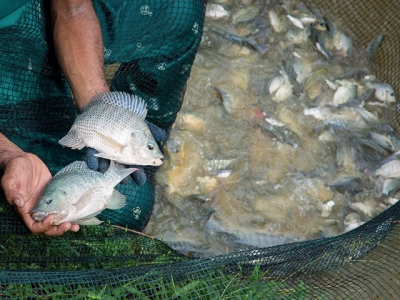Questions raised over cage cultures propensity to aggregate wild fish

The use of open net pen farms has been questioned in a new paper looking into their impacts on wild fish populations.
The researchers are concerned that the addition of open net pens could aggregate wild fish at the expense of fisheries in other parts of the water body. Photo © WorldFish
The authors of the study, which was undertaken around “an experimental tilapia farming structure” located on the Corvo River, in the Paranapanema River basin in Brazil, concluded that: “farming tilapia in cages profoundly altered the abundance and composition of the wild ichthyofauna, suggesting the need to propose effective regulations for such activities, including fisheries restrictions in farmed areas or even the prohibition of cage farming.”
The authors reached this conclusion having looked into the influence of cage aquaculture on the attraction and aggregation of wild fish over a 140 day period.
Samples were taken before and after farming began, with gillnets on the surface and near the bottom at distances from the cages ranging from 0 to 100, to 400m.
The effects of the food supply at two protein levels were also analysed, one containing 32 percen protein, the next 28 percent.
Changes in species richness and abundance were observed, with the number of individuals and the fish biomass increasing significantly just after the farming began. Some species, such as Iheringichthys labrosus, presented increased abundance near the cages, while others, such as Plagioscion squamosissimus, were more abundant far from the cages. Auchenipterus osteomystax was the most abundant species during the experiment, especially when the protein content of the pellets was higher.
The study was published under the title ‘Cage aquaculture in Neotropical waters promotes attraction and aggregation of fish’, was published in the latest issue of Aquaculture Research.
Related news
 Vĩnh Hoàn sets sights on ‘formal’ pangasius trade with Chinese seafood giant
Vĩnh Hoàn sets sights on ‘formal’ pangasius trade with Chinese seafood giant Pangasius producer Vĩnh Hoàn has paid a visit to one of China’s largest seafood companies to collaborate on “formal pangasius trade”
 Seafood enterprises proposed for simplifying the specialized inspection procedures
Seafood enterprises proposed for simplifying the specialized inspection procedures Seafood enterprises have proposed many contents related to export and import activities.
 Exporters are worried about a rapid increase in the price of pangasius catfishes
Exporters are worried about a rapid increase in the price of pangasius catfishes The price of pangasius is increasing sharply, making the farmers excited, but the export processing enterprises have difficulty in fulfilling their signed order
 MARD submits plan to develop shrimp industry
MARD submits plan to develop shrimp industry The Ministry of Agriculture and Rural Development (MARD) has submitted to the Prime Minister a national action plan for the development of the shrimp industry
 Ca Mau targets 280,000 hectares of prawn farming by 2020
Ca Mau targets 280,000 hectares of prawn farming by 2020 The Mekong Delta province of Ca Mau targets to have 280,000 hectares of prawn farming with an output of 280,000 tonnes per year by 2020.